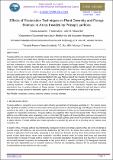Effects of Restoration Techniques on Plant Diversity and Forage Biomass in Areas Invaded by Prosopis juliflora

View/
Date
2021-12Author
Jumanne, Yohana
Moyo, Francis
Mbwambo, John
Metadata
Show full item recordAbstract
Prosopis juliflora, an invasive plant worldwide causes major threats by destructing natural ecosystem and limits provisioning of ecosystem services in the invaded areas. Attempts to manage the species and restore invaded lands have landed countries to adopt and implement different restoration options.This study tested three restoration options namely Diveting, Mulching and Seeding and their combination to assess their effectiveness in enhancing plant diversity and forage biomass. The study cleared invaded lands in Kahe Ward, Northern Tanzania and laid two blocks, each designated to address livestock pasture and conservationchallenges. Experimental blocks were laid in a complete randomized design in 10mx10m plots.Data on plant species and forage biomass were collected in each 10mx10m whereby plants were identified with the support of a botanist; their number recorded, and grass samples green and dry weight determined. The Shannon–Wiener Diversity Index was used to estimate diversity of plant species and the average values in each restoration treatment.One way ANOVA showed that, diversity of native plants was higher in control (Mean±SE =1.239±0.937)than diveting (Mean±SE =1.105±0.56) and diveting-mulching (Mean±SE =0.7703±0.55). Forage biomass was higher in control (Mean±SE =65.917±10.083)than in diveting(Mean±SE =52.425±11.15), diverting-mulching(Mean±SE =42.067±8.751) and diveting-seeding-mulching (Mean±SE =57.625±10.02)implying that restoration interventions have no positive influence on forage biomass.It is recommended that, clearing the land and leave it without restoration is enough because the restoration options do not have positive influence on plant diversity and forage biomass
